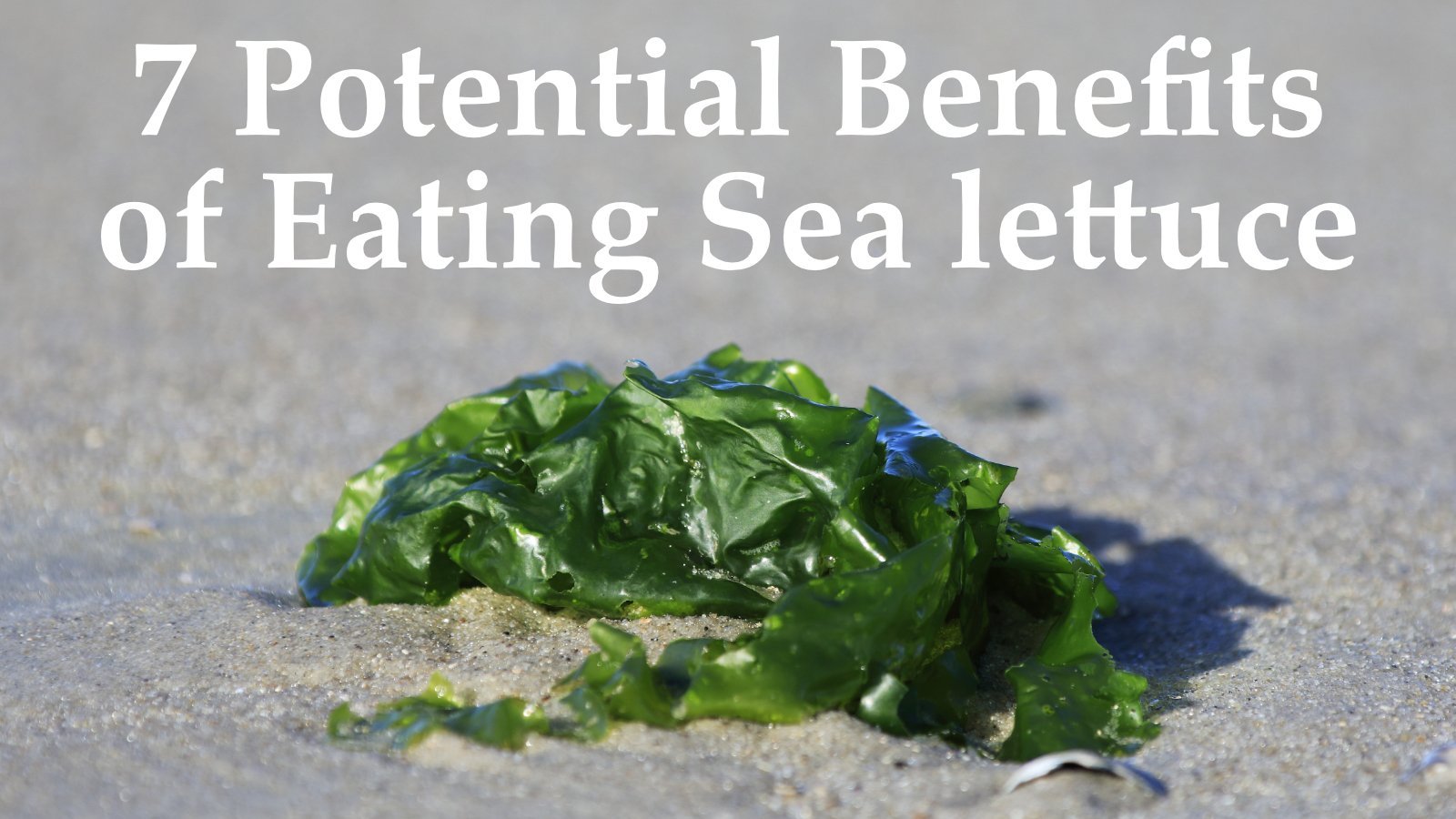Sea lettuce is a sea vegetable that many people may be unfamiliar with. While kelp, nori, Irish moss, and dulse are popular sea vegetables and well known for being healthy, we believe sea lettuce is often underappreciated. Sea lettuce can be a great addition to your diet, with many potential health benefits that include supporting the thyroid, boosting the body’s natural detoxification mechanisms, and improving bone health.
Sea lettuce is the common name given to the genus Ulva, a group of green sea vegetables usually found growing in the inter-tidal zone of coastlines all over the world. At Maine Coast Sea Vegetables, we sell the species Ulva lactuca, which is hand-harvested from the cold clear waters of the North Atlantic Ocean.
Sea Lettuce Nutrition
Nutritionally, sea lettuce is loaded with a number of essential minerals and vitamins for your body. In addition to being a great source of vegetable protein, sea lettuce contains an abundance of potassium, iron, magnesium, calcium, and iodine. For an extensive breakdown of nutrition by seaweed species, you can visit our nutrition page to learn more.

1 - Sea lettuce May Reduce Inflammation and Oxidative Stress
Inflammation and oxidative stress can result from an excess of free radicals (a natural by-product of metabolism) in the body. Free radicals are implicated in many chronic and age-related diseases such as cancer, cardiovascular disease, neurological conditions such as Alzheimer’s or Parkinson’s disease, rheumatoid arthritis, asthma, and renal disease. (1) It’s therefore critically important to support the body’s ability to remove free radicals in order to keep oxidative stress at a minimum.
Sea lettuce is known to contain bioactive compounds that have been shown to counteract free radicals. In one study, Ulva extracts were found to activate an enzymatic pathway leading to increased glutathione production. (2) Glutathione is a powerful antioxidant produced by the body that actively prevents free radicals from damaging critical proteins in the body that could result in disease if left unchecked. (3) There may be a link between maintaining healthy stores of glutathione in the body and healthy longevity, and it’s important to ensure your body is provided with foods that optimize glutathione production. (4 , 5) Glutathione levels can be reduced by chronic disease such as cancer or HIV/AIDS, or even through athletic overtraining. Orally consumed glutathione is poorly absorbed and can’t be taken as a supplement, but instead must be augmented by consuming the raw ingredients that fuel intracellular production. Sea lettuce holds promise as being one such ingredient.
Chlorophyll is another anti-inflammatory free radical “warrior compound” found in abundance in sea lettuce. A recent study found that chlorophyll from Ulva was resistant to digestive enzymes and potentially bioaccessible to humans. (6) Chlorophyll is the pigment that gives sea lettuce it’s beautiful green color and it’s been shown to help neutralize free radicals in certain human cells. (7, 8)
2 – Could Sea Lettuce Promote Longevity?
Sea lettuce is a sulfur rich food that contains up to 10 organosulfur compounds; according to our testing, sea lettuce has approximately 34 micrograms of sulfur per gram. (9) As a result of being so sulfur-rich, when sea lettuce breaks down it releases the gas hydrogen sulfide (H2S), which smells a bit like a salt marsh or rotten eggs. Unfortunately, at high concentrations of 500 ppm or more in the air, H2S is actually quite dangerous. (10) In some areas of France, sea lettuce grows in such abundance that the beaches turn green as it washes ashore. As these “green tides” decompose, they can release a plume of gas and the surrounding air can exceed safe levels of H2S within a short period of time. In Brittany, a horse was killed and its rider rendered unconscious after breathing in the fumes of rotting sea lettuce, leading it to be coined with the name “the deadly seaweed”. In a separate incident, two dogs were killed after breathing in “beach gas”. (11)
Ironically, the same gas making sea lettuce harmful when it’s released in extreme concentrations rotting on the shore in Brittany may also offer some of its most interesting potential health benefits when it’s consumed as food..
H2S was recently established as the 3rd gasotransmitter alongside nitric oxide (NO) and carbon monoxide (CO). (12) Gasotransmitters are small gaseous molecule that function similarly to neurotransmitters in the body and are involved in a vast array of physiological functions. All three gasotransmitters are toxic at high concentrations, but absolutely vital for human health at low concentrations as they positively engage almost every bodily system. Inadequate levels of these gasotransmitters have been implicated in a number of chronic conditions including heart disease, (13) chronic bacterial infections, (14) cancer, (15) and kidney disease. (16)
The physiological effects of hydrogen sulfide in the body are particularly interesting. In a healthy young body, our cells regularly divide as part of the cell cycle, but as we age, we accumulate senescent cells, which have lost the ability to divide and have altered physiology with adverse effects on neighboring cells. A recent study showed that hydrogen sulfide compounds could reduce senescent cell load by up to 50%, potentially providing a pathway towards increased lifespan and reduced incidence of age-related diseases such as Alzheimer’s disease and cancer. (17)
3 - Sea Lettuce May Help You Build Stronger Bones
Calcium is essential for strong and healthy bones, and sea lettuce is one of the best food sources of calcium on the planet! One gram of dried sea lettuce contains about 30 micrograms of calcium. (18) By comparison, parmesan cheese has about 12 micrograms per gram and skim milk has about 1 microgram per gram of product.
Another intriguing possibility, discussed in a 2017 research paper (19), is that hydrogen sulfide plays an important though not well understood role in maintaining bone density and health. This led to the development of an innovative molecule called DM-22 that generates H2S and that could be used as a therapeutant to treat bone loss. Could sea lettuce, with its abundance of sulfur compounds, be a natural approach for bone health? The science isn’t there yet, but these related findings around H2S certainly lend the idea promise!
4- Sea Lettuce May Support Thyroid Health
Iodine is an essential nutrient used by thyroid in the release of two iodine containing-hormones, triiodothyronine (T3) and thyroxine (T4). The absence of iodine in the diet can lead to iodine deficiency which eventually leads to thyroid disorders. (20)
Achieving adequate dietary intake of iodine can be achieved by adding seaweed, including sea lettuce, into your diet. Sea lettuce contains a moderate amount of iodine compared to the other seaweeds at about 43 micrograms per gram of product. This amount of iodine in comparable to iodized salt making sea lettuce a great substitute for table salt.
5 - Sea Lettuce May Help Build Muscle and Increase Muscle Recovery
Dried sea lettuce is about 15% vegetable protein which is about twice the protein content found in many popular beans, and a similar amount found per gram in tofu, making sea lettuce an intriguing protein source for vegetarians, vegans, and athletes seeking new dietary sources of protein. Protein is the building block of muscles, and research shows that achieving adequate protein intake builds muscle strength and mass while also preventing muscle loss during weight loss. (21 , 22)
In addition to being rich in protein - sea lettuce is packed with magnesium! Dried sea lettuce contains about 22.5 milligrams of magnesium per gram. This is about 83 times more magnesium than the amount found in bananas; a food popularly touted as a good source of magnesium. Magnesium is used in all functions of muscle health ranging from the regulation of muscle contractions to protein synthesis which builds and repairs muscle. (23) In addition, magnesium has a number of other roles and benefits in the body beyond muscle health. These include assisting in the regulation of blood pressure (24), it may help reduce stress and anxiety (25, 26), and it may support bone health by increasing the activation and function vitamin D (27, 28).
6 - Sea Lettuce May Support Your Immune System
Sea Lettuce can support your immune system in several ways. In one way, sea lettuce is packed full of iron. Iron deficiency has negative consequences on the immune system and this is due to iron’s role in assisting immune cell proliferation and maturation. (29) As a result, iron deficiency can lead to frequent infections in the body among a number of other serious symptoms. Fortunately, just one gram of sea lettuce will provide you with 8% of your daily iron needs! Sea lettuce is also rich in magnesium, phytochemicals, and antioxidants which have all been shown to support the immune response.
Another interesting property of sea lettuce is that it is rich in a powerful sulfated polysaccharide called Ulvan - composing between 9 and 36% of sea lettuce’s dry weight.(30) Sulfated polysaccharides are absent in terrestrial plants but abundant in seaweeds, which have different types depending on their color group. Ulvan is most abundant in sea lettuce and certain other related green seaweeds, and it has a unique molecular structure with significant biological activities. A large number of laboratory studies have shown that ulvan possesses immunomodulating, anti-inflammatory, anti‐viral, antioxidant, and anticancer activities, though trials to evaluate these properties in human subjects have yet to be carried out. (31)
7- Sea Lettuce Contains Beneficial Fiber for Digestion and Blood Sugar
Sea Lettuce is rich in both soluble and non-soluble dietary fiber. (32) Dietary fiber has been shown to lower the risk of developing coronary heart disease, stroke, high blood pressure, diabetes, obesity, and certain gastrointestinal diseases. (33)
Increasing soluble fiber in your diet improves insulin sensitivity which normalized blood sugar and prevents insulin resistance. Insulin resistance is associated with 3 serious chronic conditions; diabetes, hypertension and coronary artery disease. (34)
In addition, soluble fiber can increase bowel movement regularity by making stools softer and bulkier.
How to Consume Sea Lettuce?
Sea lettuce can be consumed in several ways. We sell sea lettuce in whole leaf, flake, and powder forms for your preference. Sea lettuce powder is popular for mixing into smoothies whereas sea lettuce flakes and whole leaf tend to be more popular for cooking into soups, salads and other dishes. You can search our recipe page for ideas on how to cook with seaweed.
You can also find sea lettuce in our triple flakes blend containing two other sea vegetables, or in our encapsulated seaweed support supplements if you prefer to consume seaweed in a pill and not through a meal.
You may also like to try sea lettuce in an herbal tea!





